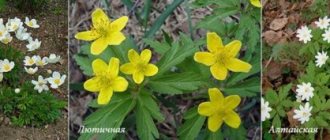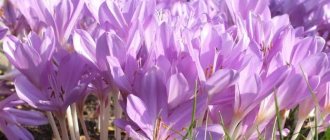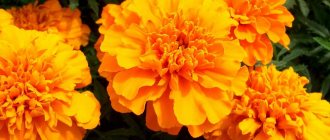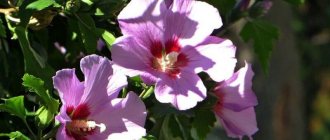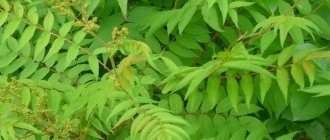Japanese anemone (autumn anemone, sleep grass, lumbago, anemone) is a spectacular perennial shrub of the Ranunculaceae family, native to Japan, China and the USA, numbering about 150 species. Large leaves in the form of dissected feathers, rich color and bud petals, fluttering even with a slight blow of wind, add a special charm to anemony. The height of the plant, depending on the variety, varies from 70 to 140 cm, and the flowering period lasts from mid-summer to mid-October, pleasing the eye of the gardener and allowing the anemone to be used in picturesque mixborders and flower beds with roses, gladioli, geraniums, hosta and hydrangea.
Recommended varieties
- "Prinz Heinrich" is a tall shrub with large, beautiful basal leaves. One inflorescence contains 15 bright red flowers. Flowering of this variety begins in late summer or early autumn.
- "September Charm" is a plant up to 130 cm high with large trifoliate serrated leaves. Graceful pink flowers with a diameter of 8 cm bloom and delight with their beauty from August to September.
- “Whirl Wind” is an unpretentious variety with decorative, serrated basal leaves. Plant height is from 80 to 100 cm, the flowers are white with light yellow stamens, collected in inflorescences of 15 pieces. Flowering lasts from August to September.
- "Konigin Charlotte" is a 1 m high perennial with three-lobed leaves. The flowers are double, 8 cm in diameter, light pink.
- “Pamina” is an early-blooming variety (July-August) with large double cup-shaped flowers of dark pink, almost burgundy color. The plants are quite compact (up to 90 cm) and are great for small gardens.
- “Profusion” is a plant with semi-double flowers of a dark purple-red color, rare for autumn anemones. Reaches a height of 90-120 cm, blooms from August to October.
- "Honorine Jobert" is a shrub with white flowers that are pinkish on the underside. The flowers consist of 6-9 sepals, the plant reaches a height of 90-120 cm. It blooms from August to October.
Using autumn anemones in garden design
Anemones are one of the most touching autumn accents and plants that can create bright, romantic spots and clearings in the garden. They are placed where there is a lack of beautiful details in the second half of the season, in secluded and dark corners that you want to “highlight”. Autumn anemones look great:
- along the paths;
- in clearings of ground covers;
- on the lawns,
- in the undergrowth;
- as a shading or “tapping” plant for groups and arrays;
- in any flower garden or mixborder.
Autumn anemones are plants of a natural style, middle ground, softening and tying compositions together.
To create compositions with autumn anemones, you can use all the classic autumn perennials - aconites, ornamental grasses, asters, black cohosh, gladioli, sedums, chrysanthemums. They can be safely introduced into classic combinations, planted with large perennials and ornamental shrubs that bloom in the first half of the season - phlox, delphiniums, peonies, irises, primroses, etc. They are often used to emphasize the beauty of varietal maples, evergreens, decorate groups of rhododendrons, hydrangeas and other shrubs with a sparse crown.
Anemones in the garden. © gartenknorze
Landing
Spill the anemone seedling with settled water at room temperature so that after 20-30 minutes you can easily remove it from the pot. Choose a suitable location for the anemone, keeping in mind that:
- Forest varieties prefer shade, and a place in the northern side of the garden or under the crowns of trees is suitable for them, so that the flower does not suffer from excess sunlight.
- Anemone varieties that are accustomed to a temperate climate are planted on the eastern side of the garden.
- In the southern part of the garden it is better to plant heat-loving varieties of flowers.
Not everything is simple with the soil mixture either, because... some anemones prefer alkaline soil - those with plots with clay soil will have to deoxidize it. To do this, use ash or dolomite flour at the rate of 450-550 g/sq.m. “Construct” the soil mixture yourself by taking humus, turf soil, coarse sand and expanded clay in a ratio of 2:2:1:0.5 or use ready-to-use PETER PEAT “Garden Soil” soil from the HOBBY line. But there are anemone varieties that grow well only in neutral or slightly acidic soil - PETER PEAT soil “For conifers” from the HOBBY line, mixed with expanded clay PETER PEAT from the VITA line and coarse sand (4:1:1), is well suited for them. If you choose a homemade version of the soil mixture, add ash (300 g/sq.m), neutralized peat PETER PEAT line AGRO (300 g/sq.m) and complex mineral fertilizer PETER PEAT “NPK 15-15-15” line MINERAL.
At the end of April - beginning of May, dig a hole 45 cm deep and Ø40 cm in the area, put a drainage layer of fine crushed stone or gravel 15 cm thick on the bottom. Remove the seedling from the pot, lower it into the hole so that the top layer of the root ball coincides with the ground level (the root collar should be above the ground) and cover with soil without compacting it. Sprinkle with water, wait until the soil settles and add again on the sides, trying not to disturb the root ball. Anemone grows quite quickly, so the distance between neighboring plants should not be less than 20-25 cm. Try to avoid planting under mature trees - the anemone will receive an excess of moisture, a lack of light and will not bloom. Mulch your plantings with dry sawdust or peat neutralized by PETER PEAT from the AGRO line to a radius of 0.4 m and a thickness of 3-4 cm.
Conditions for growing autumn anemones
Absolute unpretentiousness is the main advantage of autumn species of anemone. They grow best in fertile soil - loose, drained, not compacted and not too light, but otherwise quite unpretentious. Autumn anemones reach their greatest decorative value in moist, fresh soil, but do not tolerate dampness.
All autumn anemones prefer secluded lighting - soft, diffused light and semi-shaded “mode”; they grow well in the openwork shade cast by shrubs and ornamental trees. But anemones can bloom in the fall even when planted in bright and sunny places, provided there is sufficient watering. Anemones should not be placed in drafts or cross winds.
When choosing a place for autumn anemones, it is worth allocating a considerable area for plant growth. Anemones with autumn flowering do not like competition and leave a distance of at least 50 cm to neighboring crops immediately.
Planting of autumn anemones is carried out mainly in the spring, because in order to withstand the first winter, the plants need to take root well. The soil is improved by adding organic fertilizers. Autumn flowering anemones are planted with the rhizomes located at a depth of approximately 5 cm, and when purchasing vegetative cuttings - in compliance with their usual depth.
Autumn anemones do not like transplanting. Bushes are “relocated” only with aggressive, strong growth, dividing into several parts.
Top dressing
Top dressing 1 (before planting in the ground), options:
- aqueous solution of mullein (1:10);
- 2-year compost (4 kg/sq.m);
Feeding 2 (during flowering and every 2 weeks), options:
- liquid humic fertilizer PETER PEAT “Living force: for flower crops” (see dosage on the package);
- an aqueous solution of bird droppings.
Feeding 3 (autumn, before winter), options:
- 8-10 g nitrogen + 15-20 g phosphorus + 10-15 g potassium fertilizer;
- complex mineral fertilizer PETER PEAT “NPK 15-15-15” of the MINERAL line.
When is it better to plant anemones: in spring or autumn?
The possibility of planting anemone tubers in autumn or spring depends on the biological characteristics and winter hardiness of various species. Anemones that do not overwinter in the garden are dug up in the fall and stored until spring planting.
In temperate climates, crown and other tuberous varieties are not planted in the fall; they are quite capricious and can easily freeze. The best time to plant all types of flowers is spring. The exception is anemones with creeping rhizomes, resistant to winter frosts in temperate climates. They can be planted both in spring and autumn.
Propagation by seeds
The germination rate of anemone seed material is low, only 5-20%, because the embryo in its seeds is small and poorly developed. As a result, the plant develops slowly, and only after 2-3 years you will be able to admire its flowering. The technique of growing anemones from seeds is a little complicated, and the main thing is to sow only fresh seeds collected immediately after flowering:
- into a planting container with PETER PEAT soil “For seedlings” from the HOBBY line and adding a quarter of the volume of sand, bury the seeds 0.3-0.5 cm, sprinkle the soil on top, spray with settled water at room temperature and cover with an opaque film.
- As soon as the seeds swell, place the container in the refrigerator at + 2-4°C for 3 months.
- Sprinkle a little more soil on top (2-3 cm) and send the container with the film outside: sprinkle it with sawdust or straw and, when snow falls, make a slide out of it over the container.
- In mid-April, hardened and sprouted sprouts can be planted in open ground, keeping covering material on hand in case of return frosts.
But to save yourself from all this hassle, it is better to plant the seeds in autumn in boxes with loose soil and immediately bury them in the yard, covering them with cut sawdust or branches. Over the winter they will undergo natural freezing, and in the spring you will dig them up and plant them.
How to propagate anemone?
The best option for propagating anemones is division; to do this, you need to perform the following manipulations:
- The tubers are cut in such a way that a renewal daughter remains on each cut piece.
- The resulting seed is treated with a fungicide or potassium permanganate, and then dried.
- It is important to fill the cut areas with charcoal. After this, you can plant in the ground.
If we are talking about rhizomes, then things are even simpler. Young shoots need to be cut off from fresh rhizomes, after which they are immediately planted in the soil. It is better to use this method in the spring, as there is a greater chance that they will take root. In Japanese anemone, as the horses grow, new rosettes sprout, which can also be used as planting material along with part of the root.
Reproduction by cuttings
In March, dig up a mature anemone bush, cut it off at the root collar and use water to free the roots from the ground. Cut the cuttings 5-6 cm long and immerse them for 6 hours in a root formation stimulator, for example, “Epin” or liquid humic fertilizer PETER PEAT “Living Force: for soaking seeds.” Then place the cuttings in 12x25 cm pots filled with a peat-soil mixture with the addition of loam and sand or simply PETER PEAT soil “For seedlings” from the HOBBY line (bury the cuttings to their full length so that their tops are on the soil surface). When planting cuttings, the soil should be slightly compacted and sprinkled with sand to a thickness of 0.5-0.8 cm on top. Place the pots in a greenhouse, cover with opaque glass/film and water rarely, preventing the roots from rotting. As soon as stems with leaves appear, remove the film and increase watering - just at this time adventitious roots are forming. Once a week, feed young plantings with liquid humic fertilizer PETER PEAT “Living Force: Healthy Seedlings” and once a quarter with complex mineral fertilizer PETER PEAT “NPK 15-15-15” from the MINERAL line. Next year, the anemone can be planted in open ground.
Flower care
Autumn anemonia needs constant watering, loosening the soil and weeding. In addition, the plant must be sprayed from time to time with a special solution against snails and slugs. When working with this flower you need to be extremely careful. The flower is poisonous. If you handle it carelessly, you can get seriously burned.
If the soil is not rich enough in mineral fertilizers, fertilizer must be applied 3 times a season. The soil needs to be fertilized with nitrogen, phosphorus and potassium. Fertilizer should be applied during planting, during budding and before preparing for winter.
Autumn anemonia needs to be provided with moderate regular watering. It is advisable to mulch the soil around it, this will prevent the soil from drying out. It is also not recommended to flood the plant; this can only harm it. To prevent this from happening, the soil around the flower must be mulched with a layer of 10 cm. Mulching not only helps to normalize the flow of water to the roots, but also prevents the growth of weeds around the plant.
In spring, if there is no rain, the plant needs to be watered only once a week. In hot summer weather, you need to water more often, but with a small amount of water.
In places with a warm climate, it is not necessary to cover the plant for the winter. For regions with cold winters, if you do not insulate it for the winter, it may freeze. You can use fallen leaves, peat, or humus as a shelter. The plant must be covered with a layer of at least 15 cm. With such cover, the anemonia will overwinter well.
If you care for the plant properly, within a few years, in place of one bush, entire thickets of anemone will appear. The plant tends to grow very quickly. This may take approximately 2 - 3 years.
Propagation by tubers
Some anemone varieties have a tuberous root system, and their propagation has a number of features:
- After flowering ends in the fall, cut off the leaves and stems of the plants “under the stump”, dig up the tubers and place them in pots. The pots should be stored until spring in a room with a temperature of + 2-4°C, and before planting in the spring, a month before, in a warmer room with a temperature of + 12°C.
- About 2 weeks before planting in open ground, place the anemone tubers in shallow plates filled with water and a root growth stimulator - liquid humic fertilizer PETER PEAT “Living Force: for soaking seeds”, and wrap them in gauze so that the entire volume of the tuber is saturated with this feeding for 6 hours.
- Next, you need to place the tubers in a planting container with a soil mixture consisting of soil, peat and sand (2:1:1), cover it with transparent glass and maintain moderate soil moisture. After 10-12 days, the tubers will produce new roots and small seedlings.
- Prepare the soil in open ground (see the “Planting” subsection) and plant the tubers in pre-dug holes. Water your plantings thoroughly.
- In the first week after planting, the anemone should be in partial shade, because the sun burns the young leaves.
Description of the plant
Anemonia belongs to the anemone family. There are about 150 varieties of this species. The plant grows quickly and is completely undemanding to care. Anemonia differs from other anemones in its growth. It can grow up to 1.5 m in height. It has beautiful large feathery leaves. The flowers are similar to chamomile, but slightly larger. Hybrid species bloom with semi-double flowers.
Flower shades are white or pink. Hybrid species may have lilac or crimson. The flowers are very delicate and graceful, which is why it is very popular among garden flowers. Each autumn flower blooms for only 7 - 14 days.
Shelter for the winter
For the winter, in early November, mulch the anemone with a 10 cm thick layer of dry leaves or neutralized peat from the PETER PEAT line AGRO, and additionally cover the plant with spruce branches or branches of deciduous trees on top of it. Hybrid anemone varieties especially need this.
Some gardeners dig up anemones along with rhizomes and store them in a dark, cool, not damp room in a large container with appropriate soil, after cutting off the leaves and root stems. True, one must keep in mind that anemone does not tolerate replanting well, especially adult plants, and in this case it will most likely delay flowering.
Caring for Japanese anemone
As practice shows, a distinctive feature of culture is unpretentiousness in care, and this is undoubtedly true. In order to see the beauty of plants in full force, you will need to provide proper care, namely, irrigate the soil in a timely manner, apply fertilizers at least 3 times during the season, remove weeds, loosen and mulch the soil.
Watering
A distinctive feature of the crop is its minimal watering requirements. In the spring, irrigation should be carried out once every 7 days and only if there has been no precipitation for a long period of time. In hot summers, watering should be more frequent, but in small quantities.
It is important to understand that the root system is located in the upper layers, as a result of which moisture loss occurs as quickly as possible; in addition, the roots cannot take moisture from the lower layers
Important! It is not recommended to loosen the soil in close proximity to Japanese Anemone; it is recommended to mulch the soil
Top dressing
Often the Japanese Anemone flower grows without fertilizing, as a result of which it is impossible to see the crop in all its glory. It is recommended to apply fertilizer at least 3 times during the season:
- In spring, when the first green leaves begin to appear. In this case, organic is perfect.
- During the formation of the first buds, mineral complex fertilizers are applied.
- In the second half of September, any type of fertilizer that does not contain nitrogen is applied.
This is the only way to see all the beauty of flowers.
Shelter for the winter
In the southern regions, the crop does not need shelter. All that is required is simply to cover the plants with a thin layer of mullein
This approach is more of a precautionary measure and also allows you to avoid applying the first fertilizing
In regions with harsh climatic conditions, it is recommended to use peat, humus and dry fallen leaves as shelter. In regions where there are harsh winters or little snow, the mulch layer should be much thicker.
Protection from diseases and pests
In order to prevent the occurrence of many types of diseases and pests, it is recommended to provide careful care. Thus, the first step is to remove weeds in a timely manner. In order to slow down the growth of weeds, the soil around the bushes is mulched. In the event that the flowers are still affected by the disease, it is worth purchasing special chemicals and starting the treatment process.
Diseases and pests
- Anthracnose is brown spots that gradually grow on the leaves and stems of a plant. Over time, cracks form on the stems, the leaves turn brown and dry out, and eventually the entire above-ground part of the plant dies. Treatment: reduce the amount of watering, remove diseased parts of the plant and treat with fungicides - 2% Bordeaux mixture, oxychome or Trichodermin, Mikosan-B.
- Gray rot - in spring or autumn, brown spots form on the plant, covered with a gray fluff of a pathogenic fungus, the spores of which are very easily carried by the wind and affect nearby plants. The disease also occurs during periods of significant rainfall. Treatment: use fungicides - colloidal sulfur powder, the drug "Phyto-Doctor", reduce watering.
- Aphids are small insects 5 mm in size that feed on plant juices; during their life, they secrete a sweet substance - honeydew, which can attract other insects and thus increase the degree of damage. When there is a significant number of aphids, the surface of the affected areas becomes covered with a sticky liquid secreted by the aphids. Affected leaves curl down over time and then dry out. Treatment: use a soapy solution for spraying (2 teaspoons of liquid soap per 2 cups of water, add one cup of vegetable oil). Various insecticides can also be used.
- Leaf nematode is a small, up to 1 mm, colorless worm. Pale yellow spots begin to appear on the plant, subsequently turning brown, which then dry out: the affected fragment dies, and then the entire plant. Treatment: There are no ways to combat this pest. Destroy the affected plant, treat its growing area with insecticides - “Kinmiks”, “Fufanol”, “Bi-58”, “Lepidotsid”.
- South American leaf miner - lays eggs inside leaves. After a week, the larvae hatch and eat the insides of the leaf, causing it to wilt. Treatment: spray the plant with insecticides - organophosphorus compounds and pyrethroids.
- Slugs and snails - gnaw the leaves of garden plants, leave their sticky mucus on them and spoil the ripe crop. The object of their attention is leaves and flowers, while they do not touch large leaf veins and stems. Often, on damaged plants, in addition to mucus, piles of pest feces are visible. Treatment: first collect pests by hand. You need to remove all excess boards and stones, piles of weeded weeds from the site, mow the grass on paths and borders, as well as dry particularly wet areas and apply a solution of “Thunderstorm” and “Meta” metaldehyde. Scatter granular preparations on the ground in small piles. Do not allow animals into areas treated with metaldehyde under any circumstances! Spray the soil and plant with a 1% solution of copper or iron sulfate.
- The cutworm caterpillar - during the daytime, usually hides from sunlight under the leaves of plants or in the top layer of soil. At night, it cuts off young plants at soil level or simply gnaws leaf petioles. Treatment: manually collect caterpillars with tweezers, destroy all weeds, spray the plant with Zeta, Inta-vir, and Fas preparations.
Adding a small amount of sea salt or sea sand to the soil where anemones are grown helps in the fight against fungi..
Good luck!


